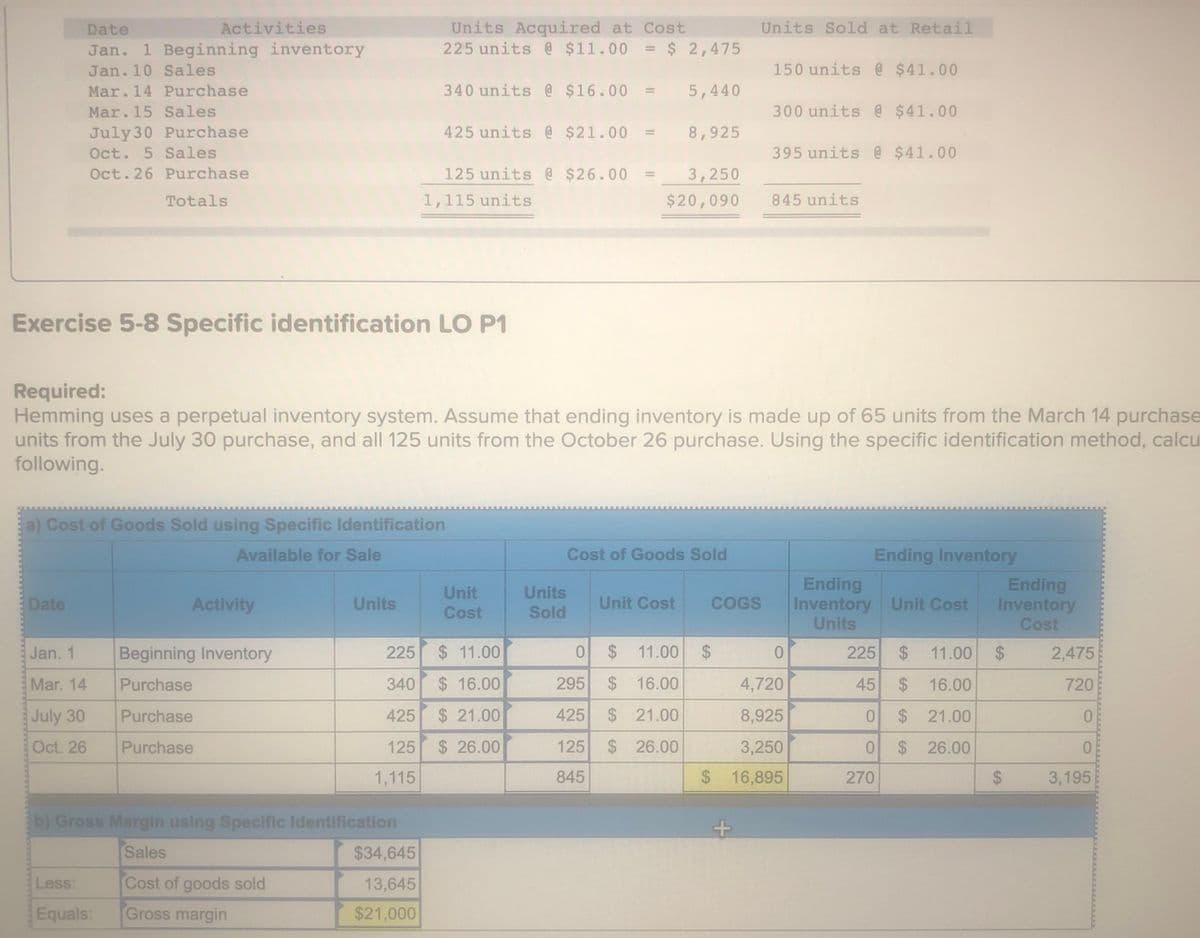Units Sold at Retail Units Acquired at Cost 225 units @ $11.00 = $ 2,475 Date Activities Jan. 1 Beginning inventory Jan. 10 Sales 150 units @ $41.00 Mar.14 Purchase 340 units @ $16.00 5,440 %3D Mar.15 Sales July 30 Purchase Oct. 5 Sales 300 units e $41.00 425 units @ $21.00 8,925 %3D 395 units @ $41.00 Oct. 26 Purchase 125 units @ $26.00 3,250 %3D Totals 1,115 units $20,090 845 units Exercise 5-8 Specific identification LO P1 Required: Hemming uses a perpetual inventory system. Assume that ending inventory is made up of 65 units from the March 14 purcha units from the July 30 purchase, and all 125 units from the October 26 purchase. Using the specific identification method, ca following. a) Cost of Goods Sold using Specific Identification Available for Sale Cost of Goods Sold Ending Inventory Units Sold Ending Inventory Unit Cost Units Ending Inventory Cost Unit Date Activity Units Unit Cost COGS Cost Jan. 1 Beginning Inventory 225 $ 11.00 $ 11.00 24 225 24 11.00 24 2,475 Mar. 14 Purchase 340 $ 16.00 295 $ 16.00 4,720 45 $ 16.00 720 July 30 Purchase 425 $ 21.00 425 $ 21.00 8,925 $ 21.00 Oct. 26 Purchase 125 $ 26.00 125 $ 26.00 3,250 $26.00 1,115 845 $ 16,895 270 %24 3,195 b) Gross Margin using Specific Identification Sales $34,645 Less: Cost of goods sold 13,645 Equals: Gross margin $21,000
Units Sold at Retail Units Acquired at Cost 225 units @ $11.00 = $ 2,475 Date Activities Jan. 1 Beginning inventory Jan. 10 Sales 150 units @ $41.00 Mar.14 Purchase 340 units @ $16.00 5,440 %3D Mar.15 Sales July 30 Purchase Oct. 5 Sales 300 units e $41.00 425 units @ $21.00 8,925 %3D 395 units @ $41.00 Oct. 26 Purchase 125 units @ $26.00 3,250 %3D Totals 1,115 units $20,090 845 units Exercise 5-8 Specific identification LO P1 Required: Hemming uses a perpetual inventory system. Assume that ending inventory is made up of 65 units from the March 14 purcha units from the July 30 purchase, and all 125 units from the October 26 purchase. Using the specific identification method, ca following. a) Cost of Goods Sold using Specific Identification Available for Sale Cost of Goods Sold Ending Inventory Units Sold Ending Inventory Unit Cost Units Ending Inventory Cost Unit Date Activity Units Unit Cost COGS Cost Jan. 1 Beginning Inventory 225 $ 11.00 $ 11.00 24 225 24 11.00 24 2,475 Mar. 14 Purchase 340 $ 16.00 295 $ 16.00 4,720 45 $ 16.00 720 July 30 Purchase 425 $ 21.00 425 $ 21.00 8,925 $ 21.00 Oct. 26 Purchase 125 $ 26.00 125 $ 26.00 3,250 $26.00 1,115 845 $ 16,895 270 %24 3,195 b) Gross Margin using Specific Identification Sales $34,645 Less: Cost of goods sold 13,645 Equals: Gross margin $21,000
Corporate Financial Accounting
14th Edition
ISBN:9781305653535
Author:Carl Warren, James M. Reeve, Jonathan Duchac
Publisher:Carl Warren, James M. Reeve, Jonathan Duchac
Chapter6: Inventories
Section: Chapter Questions
Problem 6.2BE: Perpetual inventory using FIFO Beginning inventory, purchases, and sales for Item Zeta9 are as...
Related questions
Question
Stuck

Transcribed Image Text:Units Acquired at Cost
225 units @ $11.00
Date
Activities
Units Sold at Retail
Jan. 1 Beginning inventory
= $ 2,475
Jan. 10 Sales
150 units @ $41.00
Mar.14 Purchase
340 units @ $16.00
5,440
Mar.15 Sales
300 units @ $41.00
July30 Purchase
425 units @ $21.00
8,925
%3D
Oct. 5 Sales
395 units @ $41.00
Oct.26 Purchase
125 units @ $26.00
3,250
%3D
Totals
1,115 units
$20,090
845 units
Exercise 5-8 Specific identification LO P1
Required:
Hemming uses a perpetual inventory system. Assume that ending inventory is made up of 65 units from the March 14 purchase
units from the July 30 purchase, and all 125 units from the October 26 purchase. Using the specific identification method, calcu
following.
a) Cost of Goods Sold using Specific Identification
Available for Sale
Cost of Goods Sold
Ending Inventory
Ending
Inventory Unit Cost
Units
Ending
Inventory
Cost
Unit
Units
Date
Activity
Units
Unit Cost
COGS
Cost
Sold
Jan. 1
Beginning Inventory
225
$ 11.00
$11.00
225
%24
11.00
2$
2,475
Mar. 14
Purchase
340 $ 16.00
295 $ 16.00
4,720
45 $ 16.00
720
July 30
Purchase
425
$ 21.00
425
$21.00
8,925
$21.00
Oct. 26
Purchase
125
$ 26.00
125
$26.00
3,250
$ 26.00
1,115
845
$ 16,895
270
3,195
b) Gross Margin using Specific Identification
Sales
$34,645
Less:
Cost of goods sold
13,645
Equals:
Gross margin
$21,000
%24
%24
Expert Solution
This question has been solved!
Explore an expertly crafted, step-by-step solution for a thorough understanding of key concepts.
This is a popular solution!
Trending now
This is a popular solution!
Step by step
Solved in 3 steps

Knowledge Booster
Learn more about
Need a deep-dive on the concept behind this application? Look no further. Learn more about this topic, accounting and related others by exploring similar questions and additional content below.Recommended textbooks for you

Corporate Financial Accounting
Accounting
ISBN:
9781305653535
Author:
Carl Warren, James M. Reeve, Jonathan Duchac
Publisher:
Cengage Learning

Cornerstones of Financial Accounting
Accounting
ISBN:
9781337690881
Author:
Jay Rich, Jeff Jones
Publisher:
Cengage Learning

Financial Accounting: The Impact on Decision Make…
Accounting
ISBN:
9781305654174
Author:
Gary A. Porter, Curtis L. Norton
Publisher:
Cengage Learning

Corporate Financial Accounting
Accounting
ISBN:
9781305653535
Author:
Carl Warren, James M. Reeve, Jonathan Duchac
Publisher:
Cengage Learning

Cornerstones of Financial Accounting
Accounting
ISBN:
9781337690881
Author:
Jay Rich, Jeff Jones
Publisher:
Cengage Learning

Financial Accounting: The Impact on Decision Make…
Accounting
ISBN:
9781305654174
Author:
Gary A. Porter, Curtis L. Norton
Publisher:
Cengage Learning

Intermediate Accounting: Reporting And Analysis
Accounting
ISBN:
9781337788281
Author:
James M. Wahlen, Jefferson P. Jones, Donald Pagach
Publisher:
Cengage Learning

